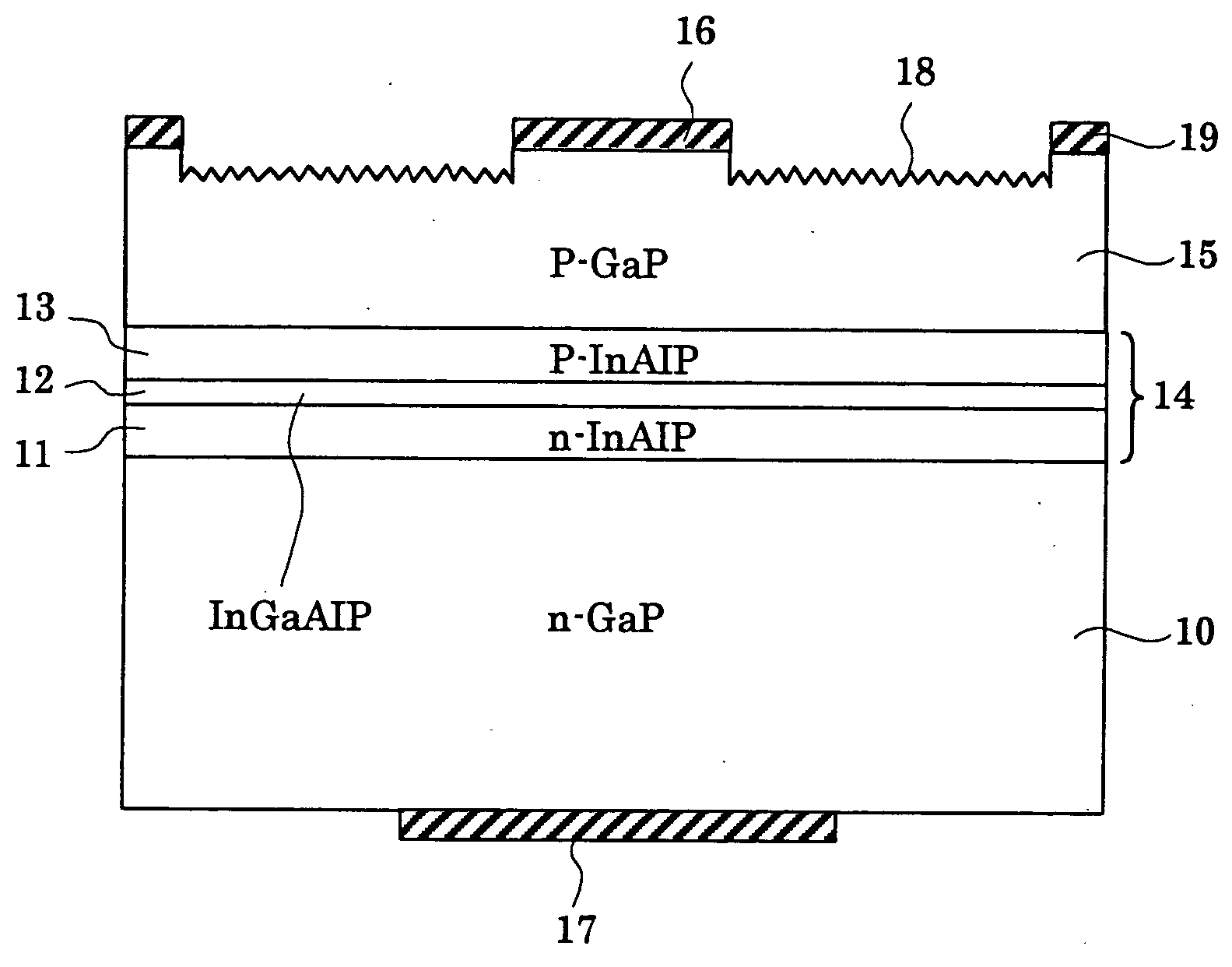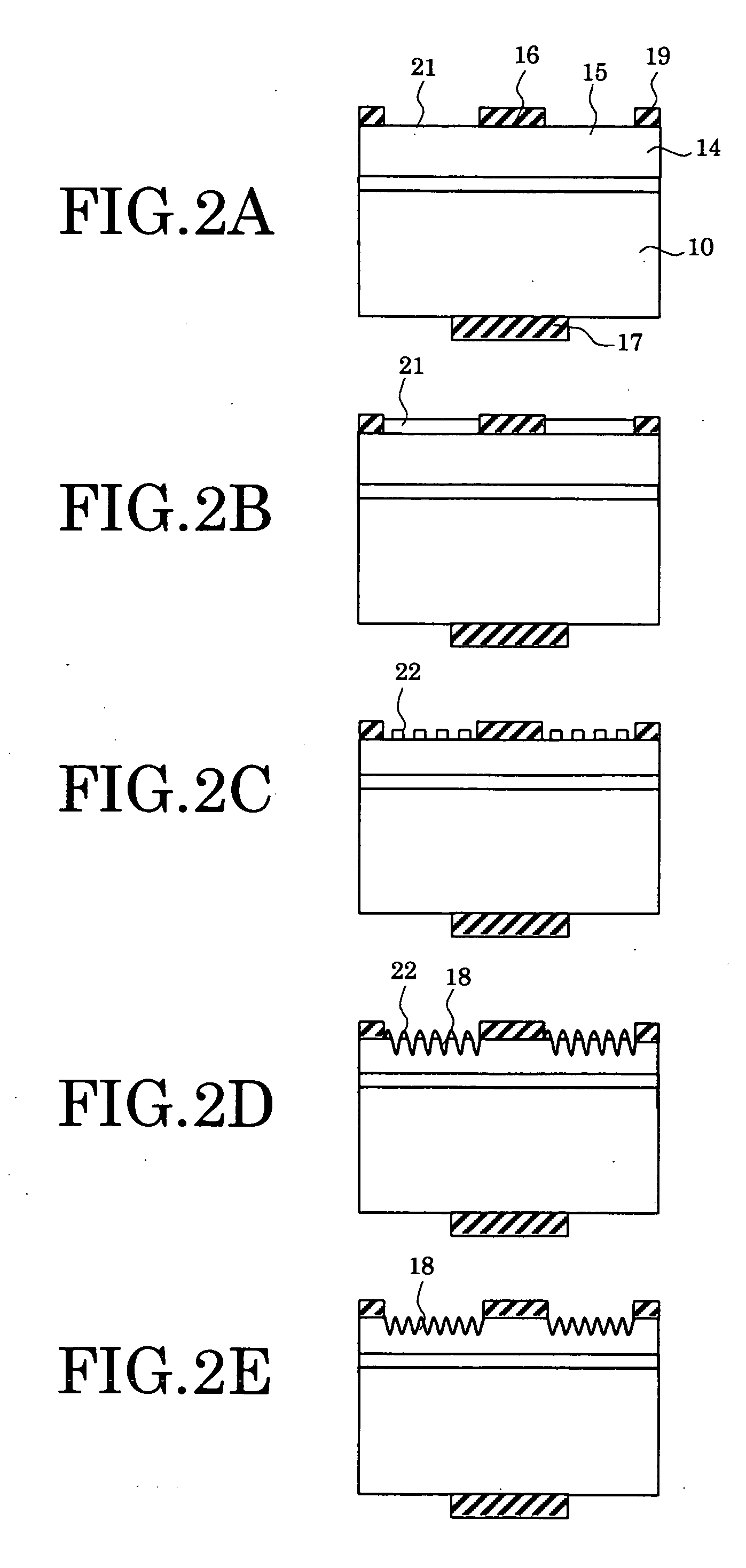Light-emitting device and method for manufacturing the same
a technology of light-emitting devices and manufacturing methods, which is applied in the direction of semiconductor devices, electrical devices, layered products, etc., can solve the problems of insufficient luminous efficiency of this type of light-emitting devices, difficult to emit the light generated within the element to the outside, and large loss of luminous energy by reflection, etc., to achieve rapid loss of rough surface structure and good economical performance
- Summary
- Abstract
- Description
- Claims
- Application Information
AI Technical Summary
Benefits of technology
Problems solved by technology
Method used
Image
Examples
example 1
[0118] Examples of the invention will be described with reference to the drawings. As shown in FIG. 2-1, the a GaAs or GaP compound semiconductor substrate 10 comprises an electrode 17 on one surface (bottom surface), and a light emitting layer 14 and a current diffusion layer 15 are epitaxially grown on the other surface of the substrate with an electrode 16 and an electrode wiring pattern 19 on the current diffusion layer. A n-GaAs, n-GaP or p-GaP is used for the semiconductor substrate, and an n-InAlP or p-InAlP cladding layer, an InGaAlP active layer and a light emitting layer are formed as a hetero-multilayer structure on the substrate. A p-InAlP, p-GaP or n-InGaAlP current diffusion layer 15 is laminated on the light emitting layer.
[0119] After applying a solution prepared by dissolving a block copolymer in a solvent on the substrate of the light-emitting element by spin-coating at a rotation number of 2500 rpm, the solvent was evaporated by pre-baking at 110° C. for 90 secon...
example 2
[0122] A substrate with the block copolymer after phase separation by the same method as in Example 1 was etched by RIE under the condition of an O2 flow speed of 30 sccm, an etching gas pressure of 13.3 Pa (100 mTorr) and an etching power of 100w to etch the separated PS and PMMA phases. Although O2 cannot etch the substrate like CF4, the PMMA phase can be selectively etched clearly. The process as in Example 1 was applied thereafter, thereby obtaining the same pattern as in Example 1. The fine roughened pattern comprises a mean diameter 2 of projections of about 60 nm with σR of 1.2, a repeating cycle of projections of about 100 nm, and a mean height of projections of about 110 nm with σH of 1.4. The substrate was processed into an element and was subjected to a surface treatment, and the element was compared with a light emitting diode with no surface processing, finding that luminance showed 21% of improvement as an average of 10 devices.
example 3
[0123] A block copolymer comprising PS with a molecular weight of 315,000 and PMMA with a molecular weight of 785,000 was dissolved in a solvent. The solution was applied on the surface of the light emitting layer of the GaP substrate as the light emitting diode used in Example 1 by spin coating at a rotation number of 3000 rpm. The solvent in the applied layer was evaporated by pre-baking at 110° C. for 90 minutes, thereby obtaining a layer with a thickness of 150 nm. The layer was then annealed at 210° C. for 4 hours to separate the PS and PMMA phases with each other, thereby forming a dot pattern of PS with a diameter of each dot of about 110 nm. The GaP substrate with the block copolymer after phase separation was etched by RIE under the condition of an O2 flow speed of 30 sccm, an etching gas pressure of 13.3 Pa (100 mTorr) and an etching power of 100W to etch the separated PS and PMMA phases. Although the GaP substrate is not etched with O2, the PMMA phase is selectively etche...
PUM
 Login to View More
Login to View More Abstract
Description
Claims
Application Information
 Login to View More
Login to View More - R&D
- Intellectual Property
- Life Sciences
- Materials
- Tech Scout
- Unparalleled Data Quality
- Higher Quality Content
- 60% Fewer Hallucinations
Browse by: Latest US Patents, China's latest patents, Technical Efficacy Thesaurus, Application Domain, Technology Topic, Popular Technical Reports.
© 2025 PatSnap. All rights reserved.Legal|Privacy policy|Modern Slavery Act Transparency Statement|Sitemap|About US| Contact US: help@patsnap.com



